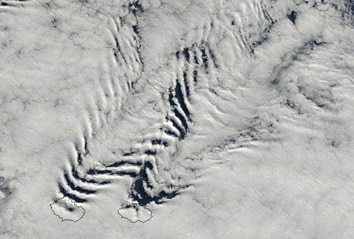Islands Awake!

Relativity is a funny thing. And here I don’t mean Einstein’s relativity, which is both funny and bizarre. No, what I’m talking about is Galilean relativity, where two objects are moving relative to one another, and you can change your frame of reference between them. You experience this all the time; in a car it seems like the scenery is moving past you, not that you’re moving. The scenery thinks the same thing (assuming scenery can think).*
For example, when a ship sails through the water, the bow pushes through the fluid and you get a wake, that V-shaped flow as the water gets pushed to the side. That’s even called a bow wave, just to be clear about it.
But you can get the same effect if the ship stays still and the water flows past it. In both cases the physics is the same, so you can look at it either way. And the fluid doesn’t have to be water; it could be, oh, let’s say air. Air flows, so it’s technically a fluid. And if you get some big stationary object with air flowing past it, we should get a bow wave, right?
Right. You do. And in fact it can even be a little more complicated, too, which means you can get some pretty astonishing phenomena, like ship waves forming downwind of the Crozet Islands in the southern Indian Ocean:
Pretty cool, isn’t it? In this image taken by NASA’s Terra Earth-observing satellite, the islands are outlined so you can see where they are. The wind is blowing to the upper right in that picture, and you can see the V-shaped waves of air as it flows past the islands.
But what about those ripples? Ah, that’s because we have to remember the air is flowing in three dimensions. It gets pushed around the islands, but also up, over them, too (the islands are volcanic, and have peaks hundreds of meters above sea level). The air oscillates up and down as it flows downwind, much like water does as it passes an obstacle.
And in this case the air has moisture in it. When the air moves up it expands and cools. When it cools its ability to hold water vapor weakens, and so water droplets condense, forming clouds. As it sinks it warms up, the water evaporates again, and the clouds go away. Up it goes again, forming clouds, then down it sinks again, and the clouds disappear. This can go on for a long way; in this case, hundreds of kilometers downwind.
In the picture you can see three big islands, and three big wakes. But at the lower left, you can see a fainter wake. Follow it to the head, and you’ll see a tiny island (Île des Pingouins—Penguin Island) just a few kilometers across there. I imagine that would be totally invisible in this image if it weren’t for the huge (though subtle) trail it creates.
I actually see this effect quite often from my house, east (downwind) of the Rocky Mountains, for exactly the same reason. The ripples can sometimes be seen clear across the sky, and it’s pretty amazing. Hmmm … this shot from Terra makes me think it would be fun to look for satellite imagery of those ripples at the same time I see them from the ground. I’ll have to try that the next time I see them from home.
*The best example of this of all time is from the screwball comedy Top Secret! Val Kilmer is sitting on a train, and as the train starts to move you see the station going past the window. When the station clears the window, you see the trees aren’t moving, and realize it really was the station moving. This scene is driven home by Kilmer lurching slightly when the train is supposedly starting to move, making the illusion seem more real (though if you watch carefully, you’ll see he lurches a fraction of a second too late).


























